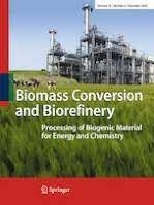Insights into the hydrolysis of Eucalyptus dunnii bark by xylanolytic extracts of Pseudozyma sp.
Dublin Core
Título
Tema
Abstract
compounds is a key aspect of sustainable strategies and is central to the biorefinery concept. Xylan is found acetylated and bound
to cellulose and lignin forming an insoluble complex in nature, and its degradation involves a collection of enzymes acting
together. To gain a better understanding of this process, the present study focuses on the elucidation of the main products
resulting from the hydrolysis of delignified Eucalyptus dunnii bark by an enzymatic extract from Pseudozyma sp. with xylanase
and acetylxylan esterase activities but no cellulase activity. Scanning electronmicroscopy (SEM) studies of the insoluble fraction
after hydrolysis revealed cracking on the surface of the material. The enzymatic activity of the crude yeast extract was evidenced
by TLC and HPLC analysis of the hydrolysate, which allowed us to detect xylose, acetylxylobiose, and acetic acid. Finally, the
principal low molecular weight products obtained from this process were characterized by nuclear magnetic resonance (NMR)
spectroscopy as xylose and 3-O-acetylxylobiose. Based on these spectroscopic and chromatographic results, it was possible to
estimate a 4:1 ratio of xylose to 3-O-acetylxylobiose. These results highlight the importance of using an enzymatic system for
effective xylan degradation.
Autor
Fuente
Editor
Fecha
Derechos
Información sobre Derechos de Autor (Por favor lea este aviso antes de abrir los documentos u objetos) La legislación uruguaya protege el derecho de autor sobre toda creación literaria, científica o artística, tanto en lo que tiene que ver con sus derechos morales, como en lo referente a los derechos patrimoniales con sujeción a lo establecido por el derecho común y las siguientes leyes (LEY 9.739 DE 17 DE DICIEMBRE DE 1937 SOBRE PROPIEDAD LITERARIA Y ARTISTICA CON LAS MODIFICACIONES INTRODUCIDAS POR LA LEY DE DERECHO DE AUTOR Y DERECHOS CONEXOS No. 17.616 DE 10 DE ENERO DE 2003, LEY 17.805 DE 26 DE AGOSTO DE 2004, LEY 18.046 DE 24 DE OCTUBRE DE 2006 LEY 18.046 DE 24 DE OCTUBRE DE 2006) ADVERTENCIA - La consulta de este documento queda condicionada a la aceptación de las siguientes condiciones de uso: Este documento es únicamente para usos privados enmarcados en actividades de investigación y docencia. No se autoriza su reproducción con fines de lucro. Esta reserva de derechos afecta tanto los datos del documento como a sus contenidos. En la utilización o cita de partes debe indicarse el nombre de la persona autora.
Formato
Idioma
Tipo
Identificador
Document Item Type Metadata
Original Format
- Fecha de agregación
- December 15, 2020
- Colección
- Bibliografía Nacional Química
- Tipo de Elemento
- Document
- Etiquetas
- Eucalyptus Dunnii Bark, Extractos xilanoticos, Hidrólisis
- Citación
- Botto, Emiliana, “Insights into the hydrolysis of Eucalyptus dunnii bark by xylanolytic extracts of Pseudozyma sp.,” RIQUIM - Repositorio Institucional de la Facultad de Química - UdelaR, accessed July 23, 2024, https://riquim.fq.edu.uy/items/show/6175.
- Archivos

